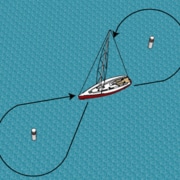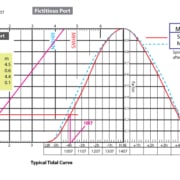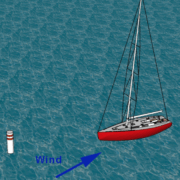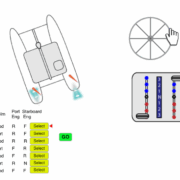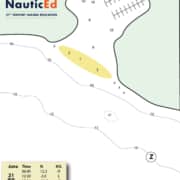Leaving a Mooring Ball in a Tidal Current
One of our students, Tom, asked the below question after he viewed our “How to Operate a Dinghy” you tube video.
“Thanks Ed, my small boat is docked in a tidal harbour and it can get tricky when tides are running strong. How should I use the outboard/tiller to move away in reverse from the mooring point? Thanks in advance. Tom.”
Here’s our answer to How to Leave a Mooring Ball in a Tidal Current.
Tom – No Ed here – Ed in NauticEd stands for Education – I mean who would name their company NauticBob or NauticJim etc – LOL.
So regarding your situation, we are first assuming you are talking about tidal flow rather than a wind situation. Of course, you can have both but let’s talk about tidal flow.
While you are connected to a mooring ball, your boat is moving at zero speed and the water is moving from front to aft so water is rushing past your boat and past the keel and the rudder. If you have your rudder off center even a little bit, your boat will turn one way and then the water will also catch the keel and turn your boat even further. It’s like trying to fly an arrow backwards – you can’t keep it straight. As you release, it’s pretty much a given that you will not be able to keep the boat straight into the current so your boat is going to turn as you release. The question is which way and how do you control it?
Imagine how the rudder works while you are still connected to the mooring ball. Since the water is flowing from front to aft just like when you are sailing, you can easily imagine then that the boat behaves the same way as when sailing; move the tiller to starboard and the boat bow turns to port, move the tiller to port and the boat bow turns to starboard. It’s the same as you do now when sailing the boat.
At the moment you release, water is still flowing over the rudder because your boat is still doing zero speed but water is still flowing. So for a while, not long, you can still point the boat as if you are sailing to control the boat. As the boat begins to move at the same speed as the water, you have zero water speed over the rudder and thus zero control. Typically, your boat will begin riding sideways to the current flow and there is not much you can do to control the boat.
Now let’s talk about using the engine. First, you might use reverse gear to back away from the mooring ball. Typically, I would not. I would let the tidal movement of water do its work to move the boat away from the mooring ball. Once clear and downstream, I’d engage forward gear to begin driving the boat fully clear and into the channel.
If you decide to engage reverse, you have to think about which way the tiller goes in order to make the boat stern move in the direction you want. This operation is covered extensively in module 5 in our Skipper Small Keelboat course for small sailboats and in our Maneuvering Under Power course for large sailboats.
Getting used to maneuvering in reverse is one of those things that you have to experience so that you burn it into muscle memory. In the maneuvering courses, we provide on-the-water exercises that you repeat to get used to reverse maneuvering. The exercises are key because no matter how much we describe it here, once you are on the water, you will forget. However, the theory part of it is simple, when maneuvering in reverse with a tiller, whichever direction the rudder is pointing when you draw a line from the front of the tiller to the back of the rudder, that is the way the stern moves. KEY POINT however, that is when the boat is actually moving backward through the water i.e. you might have only switched to reverse while moving forward and in this case, it doesn’t work – you have to wait until the boat moves backward through the water.
In the exercises we present in the courses, we have you doing backward figure 8’s. After only a few, you get the hang of which way you instinctively move the rudder. We have you doing both rudder and outboard independently so you get the hang of how the boat reacts with each separately.
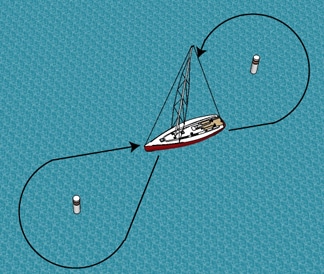
Once you have mastered reverse, you will instinctively be able to maneuver your boat easily in this situation.
So to answer the question specifically, once your boat is floating freely in the tidal current and you want to keep it moving straight back downstream away from the mooring buoy while in reverse gear, position the tiller so that the tiller to rudder line is pointing in the direction you want the stern of the boat to move. Regarding using the rudder tiller or the engine tiller, that is your call. Test out how your boat reacts to each. Note that it is very difficult to do both at the same time as you usually need a hand spare. Lock one or the other in the centerline.
See the animation here:
Once clear, shift the engine into forward gear and drive the boat as desired.

